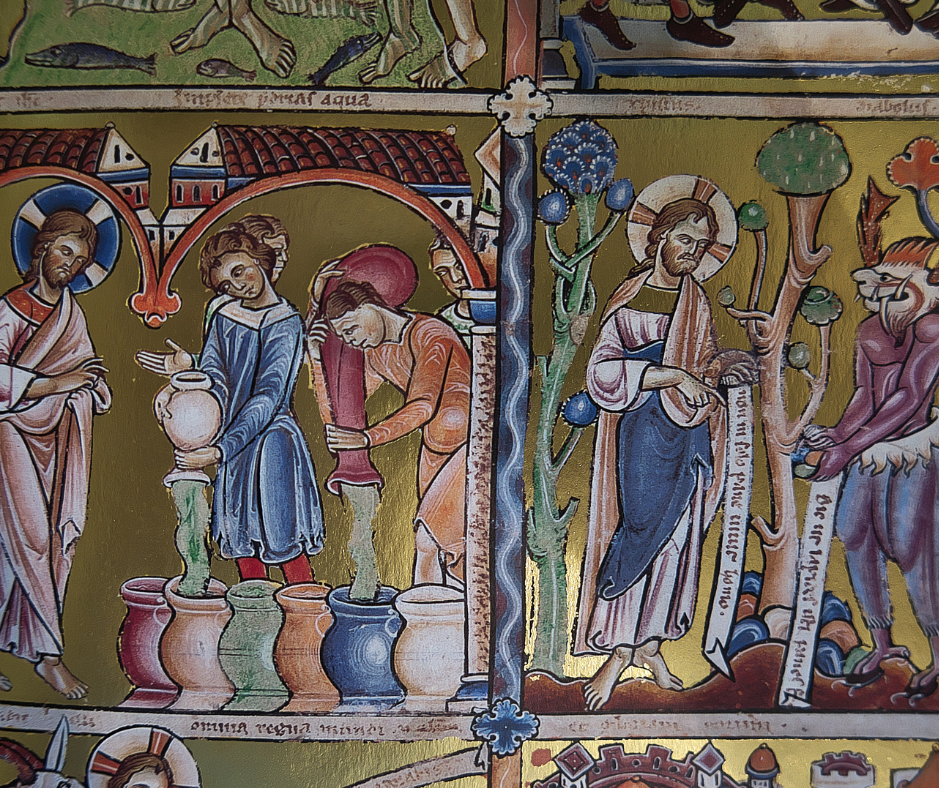The Sacred Rhythm of Orthodox Fasting: A Historical Perspective
A guest post by Zeeva Usman

The Temptation of Christ and His First Miracle, Scenes from the Life of Christ, Jl FilpoC, CC BY-SA 4.0 <https://creativecommons.org/licenses/by-sa/4.0>, via Wikimedia Commons
Orthodox fasting is more than abstinence; it is a spiritual discipline woven into the Christian life. Rooted in Scripture and tradition, fasting aligns believers with Christ’s journey, offering opportunities for humility, repentance, and deeper communion with God. This practice has shaped the rhythm of the Church from early Christianity to today, mirroring Christ’s 40-day fast and the broader liturgical cycle.
The Beginnings
In the early centuries of Christianity, fasting was established as a key spiritual discipline following Christ’s example in the wilderness. Early Christians viewed it as a means of purification, repentance, and devotion. The Desert Fathers—Christian ascetics in the 4th century—helped solidify fasting as central to Christian life. For them, fasting was not merely abstaining from food but subduing worldly passions and drawing closer to God.
As these practices spread, the Church integrated fasting into its liturgical structure, creating a rhythm of preparation and renewal. Specific fasting periods, such as Great Lent, Advent, and the Apostles’ Fast, were formalized over time, shaping believers’ spiritual lives.
By the 4th century, fasting had become deeply woven into the Orthodox liturgical calendar. It was established as preparation for major feasts, particularly Pascha (Easter), the central celebration of the Orthodox faith. Great Lent, a 40-day period of fasting, prayer, and repentance, became the most significant fasting season, reflecting Christ’s time in the wilderness. Other fasts, such as the Nativity Fast (Advent) and the Apostles' Fast, reinforced a cycle of spiritual preparation throughout the year. Through these practices, the Church cultivated a sacred rhythm of fasting and feasting, aligning believers’ lives with the mysteries of Christ.
Fasting in the Spiritual Life
Fasting in Orthodox Christianity is inseparable from prayer and almsgiving. The Church teaches that fasting without prayer is incomplete and that prayer without fasting lacks discipline. More than physical abstinence, fasting is a form of spiritual warfare—a way to resist worldly distractions and strengthen dependence on God.
The Church Fathers emphasized that fasting was not just about dietary rules but about cultivating humility and self-control. As the Church grew, specific guidelines developed regarding permitted foods during fasts. However, the core purpose remained unchanged: fasting directs the soul toward God, fostering spiritual renewal and deeper communion with Him.
Fasting and Feasting
While fasting is central to Orthodox spirituality, so is feasting. Just as fasting prepares the soul, feasting celebrates the joy of Christ’s Resurrection and God’s grace. The liturgical calendar weaves together times of self-denial and rejoicing, reflecting the ebb and flow of Christian life.
Fasting is not about deprivation but reorientation—shifting focus from material sustenance to spiritual nourishment. Likewise, feasting is not about indulgence but gratitude, celebrating God’s blessings with a renewed heart. This balance between fasting and feasting embodies the rhythm of Christian life: preparation, purification, and ultimate joy in Christ’s victory over death.
Modern Orthodoxy
In today's constantly evolving society, the ancient rhythm of Orthodox fasting remains a powerful way for believers to reconnect with God. Despite modern distractions, fasting continues to offer a spiritual counterbalance to consumer-driven culture. Orthodox fasting still follows the patterns established by the early Church, though it has adapted to contemporary needs. Online communities and digital resources help believers share fasting tips, offer encouragement, and explore the spiritual benefits of fasting. The sacred rhythm remains unchanged, even as it evolves.
For Orthodox Christians, fasting is not merely abstinence from food; it aligns the believer with Christ’s life, from His suffering to His Resurrection. As the faithful observe the fasts and celebrate the feasts, they enter a timeless rhythm of spiritual transformation, connecting them to the entire Body of Christ, both past and present.
Zeeva Usman is a content marketing manager at Peter and Petra. She is leading the remote working training program at Second Adam Church and content marketing specialist at Church Marketing Agency. When not working she loves to worship and sing for the Lord Jesus.
To learn more about Lent and preparation for Easter, read Walk Through the Wilderness, a devotional of Lenten reflections from the Christian History Institute staff.
For more on fasting and feasting, read CH issue #125, Food and faith.



